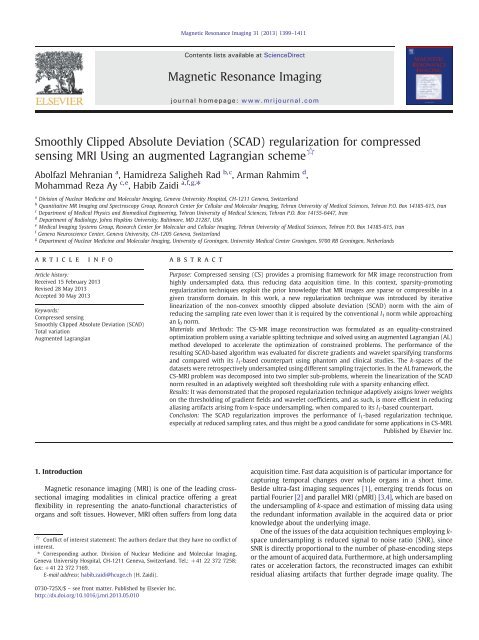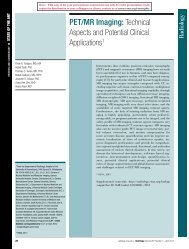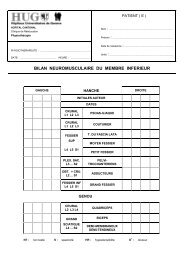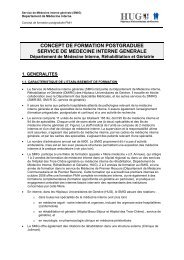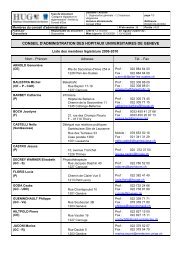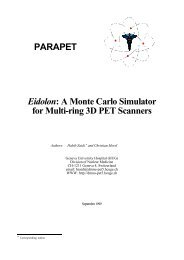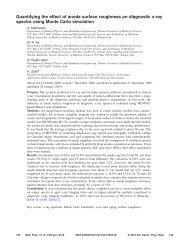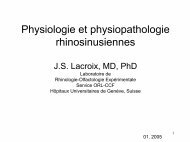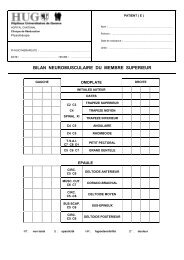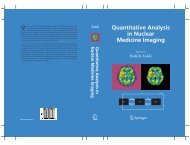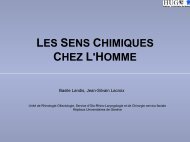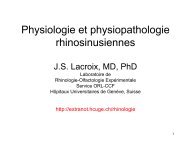(SCAD) regularization for compressed sensing MRI Using ... - PINLAB
(SCAD) regularization for compressed sensing MRI Using ... - PINLAB
(SCAD) regularization for compressed sensing MRI Using ... - PINLAB
Create successful ePaper yourself
Turn your PDF publications into a flip-book with our unique Google optimized e-Paper software.
1400 A. Mehranian et al. / Magnetic Resonance Imaging 31 (2013) 1399–1411reduced SNR and residual artifacts, in fact, arise from the illconditioningof the inverse problems encountered in this context [5].Regularization and explicit incorporation of prior knowledge duringreconstruction of MR images are efficient ways to improve theconditioning of the problem and thus to penalize unsatisfactory andnoisy solutions. Several <strong>regularization</strong> schemes have been assessedin this context. Tikhonov <strong>regularization</strong> suppresses noise andartifacts by favoring smooth image solutions [6–8].The truncatedsingular value decomposition attempts to reduce noise by truncatingsmall singular values on the assumption that noise amplification isassociated with small singular values of solution [6,9]. Both<strong>regularization</strong>s are based on l 2 norm minimization and tend to blurthe details and edges in the estimated image [6,10]. Recentdevelopments in <strong>compressed</strong> <strong>sensing</strong> have introduced sparsity<strong>regularization</strong> techniques, which have garnered significant attentionin MR reconstruction from highly undersampled k-spaces. In fact, CS-<strong>MRI</strong> reduces noise and aliasing artifacts by exploiting the priorknowledge that MR images are sparse or weakly sparse (compressible)in spatial and/or temporal domains [11,12], in a giventrans<strong>for</strong>m domain such as wavelets, Fourier, discrete gradients[11,13] or in learned dictionaries [14,15]. By establishing a direct linkbetween sampling and sparsity, CS theory provides an alternativesampling criterion to conventional Shannon–Nyquist theory [16,17].According to this theory, it is possible to accurately recover theunderlying signal or solution from the data acquired at samplingrates far below the Nyquist limit as long as i) it is sparse or has asparse representation in a given trans<strong>for</strong>m domain and ii) thesampling pattern is random or such that the aliasing artifacts areincoherent (noisy-like) in that domain [17,18].Sparsity <strong>regularization</strong> aims at finding a solution that has thesparsest representation in a given sparse trans<strong>for</strong>m domain. In thisregard, the l 0 norm is an ideal regularizer (or prior), which counts thenumber of non-zero elements of the solution [19]. However, thisnon-convex prior results in an intractable and non-deterministicpolynomial-time hard (NP-hard) optimization problem. For thisreason, the l 1 norm has been widely used as a convex surrogate tothe l 0 norm and has gained popularity in conjunction with wavelet[20,21] and discrete gradient trans<strong>for</strong>ms [22]. The latter is known astotal variation (TV) <strong>regularization</strong> [23–26] and has been shown tooutper<strong>for</strong>m l 2 -based <strong>regularization</strong>s in CS-(p)<strong>MRI</strong> [27,28]. The l 1 -based <strong>regularization</strong>s; however, show a lower limit in the requiredsampling rate and hence in the maximum achievable accelerationrate [29]. In addition, the l 1 norm is known to be biased due to overpenalizinglarge sparse representation coefficients [30]. To furtherreduce the sampling rate and approach l 0 norm minimization,Candes et al. [30] proposed a reweighted l 1 norm minimization inwhich the sparsity induced by the l 1 norm is enhanced by theweighting factors that are derived from the current estimate of theunderlying solution. This approach has been successfully applied inCS-(p)<strong>MRI</strong> [31–33]. Furthermore, non-convex priors homotopicallyapproximating the l 0 norm have also been studied showing theimproved per<strong>for</strong>mance of the resulting <strong>regularization</strong> techniques inthe recovery of strictly sparse signals [19,34,35]. However, MRimages are usually compressible rather than sparse, hence it isdesirable to exploit the sparsity-promoting properties of both l 1 andl 0 norm minimizations [36]. To improve the properties of l 1 andpseudo l 0 norms in terms of unbiasedness, continuity and sparsity,Fan and Li [37] proposed a non-convex prior called smoothly clippedabsolute deviation (<strong>SCAD</strong>) norm in the context of statistical variableselection. This norm has been designed to not excessively penalizelarge valued coefficients as in the l 1 norm and at the same timeapproaching an l 0 norm. Teixeira et al. [38] have previously studiedthe <strong>SCAD</strong> <strong>regularization</strong> <strong>for</strong> sparse signal recovery using a secondordercone optimization method. In this work, we employed, <strong>for</strong> thefirst time, the <strong>SCAD</strong> <strong>regularization</strong> with discrete gradients andwavelet trans<strong>for</strong>ms in the context of CS-<strong>MRI</strong> and solved the resultingproblem using variable splitting and augmented Lagrangian (AL)methods. In the AL framework, the optimization problem is reducedto simpler sub-problems, leading to an improved convergence rate incomparison with state-of-the-art and general purpose optimizationalgorithms [39,40]. In this framework, the linearization of the <strong>SCAD</strong>norm resulted in a weighted soft thresholding rule that exploits theredundant in<strong>for</strong>mation in image space to adaptively threshold thegradient fields and wavelet coefficients and to effectively reducealiasing artifacts. In this study, we compared the per<strong>for</strong>mance of theproposed <strong>SCAD</strong>-based <strong>regularization</strong> with the conventional l 1 -basedapproach using simulation and clinical studies, where k-spaces wereretrospectively undersampled using different sampling patterns todemonstrate the potential application of the proposed method in CS-MR image reconstruction.2. Materials and methods2.1. TheoryFor a single-coil CS-<strong>MRI</strong>, we <strong>for</strong>mulate the following CSacquisition model:y ¼ ΦFx þ nwhere γ∈C M is the undersampled k-space of the underlying MRimage, x∈R N , contaminated with additive noise n∈C M . F∈C N × N is aFourier basis through which x is being sensed and Φ∈R M × N is asampling matrix that compresses data to M b N samples. The matrixA = ΦF is often referred to as <strong>sensing</strong> or Fourier encoding matrix.The direct reconstruction of x from y (by zero-filling the missing dataand then taking its inverse Fourier trans<strong>for</strong>m) results in aliasingartifacts, which is attributed to the ill-conditioning of matrix A. Asaresult, <strong>regularization</strong> is required to regulate the solution spaceaccording to a prior knowledge. The solution can there<strong>for</strong>e beobtained by the following optimization problem:1^x ¼ argim x2 ‖ΦFx−y‖2 þ RðxÞwhere the first term en<strong>for</strong>ces data consistency and the second one,known as regularizer, en<strong>for</strong>ces data regularity. In the CS-<strong>MRI</strong> context,sparse l 1 -based regularizers have been widely used because the l 1norm is a convex and sparsity promoting norm, thereby the resultingproblem is amenable to optimization using convex programming.NThese regularizers are of the <strong>for</strong>m R(x) =λ‖Ψx‖ 1 = λ ∑ i =1 |[Ψx] i |,where λ > 0 is a <strong>regularization</strong> parameter controlling the balancebetween <strong>regularization</strong> and data-consistency and Ψ is a sparsifyingtrans<strong>for</strong>m such as discrete wavelet, Fourier or gradient trans<strong>for</strong>m.The CS approach makes it possible to accurately reconstruct theimage solution of problem (1), provided that i) the underlying imagehas a sparse representation in the domain of the trans<strong>for</strong>m Ψ, i.e.most of the decomposition coefficients are zero, while few of themhave a large magnitude, ii) the <strong>sensing</strong> matrix A should be sufficientlyincoherent with the sparse trans<strong>for</strong>m Ψ, thereby the aliasing artifactsarising from k-space undersampling would be incoherent (noise like)in the domain of Ψ [11,18].2.2. Proposed methodThe sparsity or compressibility of an image solution induced by l 1based regularizers can be increased by introducing a non-convexpotential function, ψ λ , as follows:RðxÞ ¼ ∑ ψ λ j½ΨxŠ ij ½3Ši¼1½1Š½2Š
A. Mehranian et al. / Magnetic Resonance Imaging 31 (2013) 1399–14111403phantoms and clinical datasets. To demonstrate the per<strong>for</strong>mance of<strong>SCAD</strong> <strong>regularization</strong> <strong>for</strong> highly undersampled MR reconstruction, wefirst per<strong>for</strong>med a set of simulated noisy data generated from theanthropomorphic XCAT phantom. In this experiment, the k-space ofa 512 × 512 slice of the XCAT phantom was sampled by 8 equallyspaced radial trajectories as well as a single-shot variable-densityspiral trajectory, respectively corresponding to 98.33% and 98.30%undersampling, with 20 dB complex noise added to k-spaces. For theevaluation of the proposed <strong>SCAD</strong>-ADMM algorithm with 3D discretegradients, an MR angiography (MRA) dataset in a patient witharterial bolus injection was obtained from Ref. [49]. The dataset hasbeen synthesized from projection data collected <strong>for</strong> 3 frames persecond <strong>for</strong> a total of 10 s (31 collected frames) and linearlyinterpolated into 200 temporal frames. In this study, 30 time framesof this dataset (with resolution of 256 × 256) were chosen and their3D k-space was retrospectively undersampled using a stack of 2Dsingle-shot variable-density spiral trajectories, yielding 78.7% undersampling.The per<strong>for</strong>mance of the algorithm was further evaluatedwith 2D translation-invariant wavelets using two brain datasets. Atransverse slice of a 3D brain T1-weighted <strong>MRI</strong> dataset (of the size181 × 217 × 181) was obtained from the BrainWeb database(McGill University, Montreal, QC, Canada) [50], which has beensimulated <strong>for</strong> 1 mm slice thickness, 3% noise and 20% intensity nonuni<strong>for</strong>mity.The image slice was zero-padded to 256 × 256 pixelsand its k-space was retrospectively undersampled by a variabledensityrandom sampling pattern with 85% undersampling. Finallyin clinical patient study, a Dixon <strong>MRI</strong> dataset was acquired on aPhilips Ingenuity TF PET–<strong>MRI</strong> scanner (Philips Healthcare, Cleveland,OH). The <strong>MRI</strong> subsystem of this dual-modality imaging system isequipped with the Achieva 3.0 T X-series <strong>MRI</strong> system. A whole bodyscan was acquired using a 16-channel receiver coil and a 3D multiecho2-Point FFE Dixon (mDixon) technique with parameters: TR =5.7 ms, TE1/TE2 =1.45/2.6, flip angle =10º and slice thickness of2 mm, matrix size of 480 × 480 × 880 and in plane resolution of0.67 mm × 0.67 mm. From this sequence, in-phase, out-of-phase,fat and water (IP/OP/F/W) images are reconstructed. For thecomparison of <strong>SCAD</strong>- and l 1 -based wavelet <strong>regularization</strong>s, arepresentative image slice of OP image was zero-padded to512 × 512 pixels and its k-space was retrospectively undersampledby the Cartesian approximation of radial trajectory with 83%undersampling. Note that the k-spaces of the studied datasetswere obtained by <strong>for</strong>ward Fourier trans<strong>for</strong>m of the image slices.All of our CS-MR reconstructions were per<strong>for</strong>med in MATLAB2010a, running on a 12-core workstation with 2.40 GHz Intel Xeonprocessors and 32 GB memory. The improvement of image qualitywas objectively evaluated using peak signal to noise ratio (PSNR)and mean structural similarity (MSSIM) index, [51] between theground truth fully sampled image, x⁎ and the images reconstructedby l 1 - and <strong>SCAD</strong>-based <strong>regularization</strong>s, x. The PSNR isdefined as:0maxjx 1i jPSNR x; x 1≤i≤N¼ 20 log 10 BqffiffiffiffiffiffiffiffiffiffiffiffiffiffiffiffiffiffiffiffiffiffiffiffiffiffiffiffiffiffiffiffiffiC@ 1N ∑N i¼1jx i −x ij 2 AMSSIM, which evaluates both nonstructural (e.g., intensity) andstructural (e.g., residual streaking artifacts) deviations of an imagefrom its reference image, is given by:SSIM x; x ¼ð2μ x μ x þC 1 Þð2σ xx þC 2 Þ μ 2 x þ μ x 2 þC 2 1 σx þ σ x 2 þC 2MSSIM x; x ¼ 1 LX Ll¼1SSIM x l ; x lwhere the mean intensity, μ and standard deviation σ, ofx and x⁎and their correlation coefficient σ xx* , are calculated over L localimage patches. The constants C 1 =(K 1 D) 2 and C 2 =(K 2 D) 2 areintroduced to avoid instability issues, where D is the dynamic rangeof pixel values. K 1 = 0.01 and K 2 = 0.03 according to Ref. [51].Based on this metric, a perfect score, i.e. MSSIM (x, x⁎) =1 isachieved only when the image x is identical to the ground truthimage x⁎. In addition, the reconstructed images were qualitativelycompared through visual comparison and intensity profiles. In allreconstructions, a tolerance of η =1×10 −4 was used in Algorithm 1to declare the convergence of the algorithms.Fig. 2. Reconstruction of the XCAT phantom through zero-filling, gradient-based l 1 and <strong>SCAD</strong> ADMM algorithms from the k-spaces sampled by 8 equally spaced radial Fouriertrajectories (top) and a variable-density spiral trajectory (bottom), respectively, corresponding to 98.33% and 98.30% undersampling. The difference images show the deviationsof the reconstructed images from the true fully sampled image.
1404 A. Mehranian et al. / Magnetic Resonance Imaging 31 (2013) 1399–1411Table 1Summary of the peak signal-to-noise ratio (PSNR) and mean structural similarity (MSSIM) per<strong>for</strong>mance of the studied algorithms in CS-<strong>MRI</strong> with respect to fully sampled(reference) images.Dataset PSNR (dB) SSIM Iterations | CPU time/Iter. (s)Zero-Filling L1 <strong>SCAD</strong> Zero-Filling L1 <strong>SCAD</strong> L1 <strong>SCAD</strong>XCAT (Radial) 17.66 26.03 35.89 0.21 0.83 0.98 2130 0.06 2862 0.08XCAT (Spiral) 14.21 31.41 52.66 0.16 0.84 0.99 2489 0.07 2745 0.08MR Angiogram 24.65 28.32 28.60 0.64 0.69 0.70 94 0.83 138 0.97BrainWeb 14.84 18.52 20.36 0.39 0.59 0.62 335 0.49 354 0.66Brain mDixion 23.76 27.91 29.13 0.31 0.98 0.99 96 1.84 102 2.12The number of iterations and the computation (CPU) time per iteration (in seconds) are also reported.4. Results4.1. CS-MR Image ReconstructionsFig. 2 shows the results of image reconstruction in XCAT phantom<strong>for</strong> radial and single-shot variable density spiral trajectories, in firstand second rows, respectively, and compares the images reconstructedby zero-filing, l 1 - and <strong>SCAD</strong>-based ADMM algorithms withdiscrete gradient sparsifying trans<strong>for</strong>m. This figure also shows thedifference images between true and reconstructed images. As can beseen, the proposed <strong>regularization</strong> technique has efficiently recoveredthe true image and outper<strong>for</strong>med its TV counterpart in bothFig. 3. (A) Reconstruction of the MR angiogram dataset through zero-filling, gradient-based l 1 and <strong>SCAD</strong> ADMM algorithms using a 3D stack of a single-shot variable-density spiraltrajectory (78.7% undersampling). The L1 and <strong>SCAD</strong> images are shown with the same display window. (B) The illustration of k-space undersampling pattern. (C) The comparisonof intensity profiles of reconstructed images along the dash line shown on the true image.
A. Mehranian et al. / Magnetic Resonance Imaging 31 (2013) 1399–14111405Fig. 4. (A) Reconstruction of the BrainWeb phantom through zero-filling, wavelet-based l 1 and <strong>SCAD</strong> ADMM algorithms using a variable density random sampling (85%undersampling). The L1 and <strong>SCAD</strong> images are shown with the same display window. (B–C) As in Fig. 3.cases. In this simulation study with extremely high undersampling, theinvolved parameters, i.e. ρ, λ and a, wereheuristicallyoptimizedtoobtain the best case per<strong>for</strong>mance of the algorithms. For the radialsampling results, the optimized parameters were set to ρ =0.5,λ =0.03, a =3.7<strong>for</strong><strong>SCAD</strong>andρ =0.2,λ = 0.05 <strong>for</strong> TV. Similarly, in thespiral sampling, the parameters were set to ρ = 0.15, λ = 0.15, a =3.7<strong>for</strong> <strong>SCAD</strong> and ρ =0.5,λ = 0.15 <strong>for</strong> TV. The quantitative evaluation of thealgorithms in terms of PSNR and SSIM index is presented in Table 1.Theresults show that the <strong>SCAD</strong> <strong>regularization</strong> significantly improves peaksignal to noise ratio in the reconstructed images and also gives rise to aperfect similarity between the true and the reconstructed images. Itshould be noted that at sufficiently high sampling rate the l 1 -based TV<strong>regularization</strong> can restore the underlying image as faithfully as the<strong>SCAD</strong> <strong>regularization</strong>. However, we purposefully lowered the samplingrate to evaluate the ability of algorithms in CS-<strong>MRI</strong> from highlyundersampled datasets.In Fig. 3 (A), a representative slice of the reconstructed MRAimages is compared with the fully sampled ground truth. The visualcomparison of the regularized reconstructions shows that both l 1 -based TV and <strong>SCAD</strong> <strong>regularization</strong>s have noticeably suppressed noiseand undersampling artifacts in comparison with zero-filling, which isin fact an un-regularized reconstruction. However, a close comparisonof the images reveals that the <strong>SCAD</strong> <strong>regularization</strong> results in a higherimage contrast (see arrows), since it exploits the weighting factorsthat suppress <strong>regularization</strong> across boundaries. Fig. 3 (B) also showsthe k-space trajectory used <strong>for</strong> undersampling and the intensityprofiles of the reconstructed images along the dashed line shown onthe true image. The profiles also demonstrate that the <strong>SCAD</strong><strong>regularization</strong> technique can improve the per<strong>for</strong>mance of its TVcounterpart. The algorithms were also quantitatively evaluated basedon PSNR and MSSIM metrics. The results summarized in Table 1further demonstrate the outper<strong>for</strong>mance of the proposed <strong>regularization</strong>technique. Note that during image reconstruction of this and theother two brain datasets, we first optimized the involved parametersof the ADMM algorithm, i.e. λ and ρ, <strong>for</strong>l 1 -based <strong>regularization</strong>s toobtain the best case per<strong>for</strong>mance. Then, we optimized the per<strong>for</strong>manceof the <strong>SCAD</strong> <strong>regularization</strong> using the same values <strong>for</strong> the scaleparameter a in Eq. (16). For this dataset, the optimal parameters wereset to λ =1800,ρ = 1.2 and a = 100.Figs. 4 and 5 (A) show the image reconstruction results of thesimulated (BrainWeb) and clinical brain Dixon datasets, respectively.As mentioned earlier, translation-invariant wavelets wereemployed as sparsifying trans<strong>for</strong>ms. As can be seen in both cases, theproposed <strong>regularization</strong> technique depicts improved per<strong>for</strong>mance in
1406 A. Mehranian et al. / Magnetic Resonance Imaging 31 (2013) 1399–1411Fig. 5. (A) Reconstruction of the clinical brain Dixon (out-of-phase) dataset through zero-filling, wavelet-based l 1 and <strong>SCAD</strong> ADMM algorithms using a radial trajectory (87.54%undersampling). The L1 and <strong>SCAD</strong> images are shown with the same display window. (B–C) As in Fig. 3.reducing the aliasing artifacts and restoring the details in comparisonwith l 1 -based <strong>regularization</strong> (see arrows). In Figs. 4 and 5(B), k-space undersampling patterns as well as line profiles of thereconstructed images along the dash line in true images areshown. The line profiles demonstrate that the <strong>SCAD</strong> <strong>regularization</strong>can restore the true profiles more faithfully. As will be elaborated inthe Discussion section, this regularizer exploits the redundantin<strong>for</strong>mation in the image being reconstructed in order to suppressthe thresholding of wavelet coefficients of image features andthereby to improve the accuracy of the reconstructed images. Thequantitative evaluations of the l 1 -based and <strong>SCAD</strong> <strong>regularization</strong>spresented in Table 1 demonstrate that the proposed regularizerachieves an improved SNR and structural similarity over itscounterpart. The optimal parameters obtained <strong>for</strong> the simulated(BrainWeb) and clinical brain Dixon datasets were set to λ =3,ρ =0.2 and to λ =3,ρ = 0.5 and a = 10, respectively.4.2. Convergence rate and computation timeTable 1 summarizes the number of iterations and the computation(CPU) time per iteration <strong>for</strong> l 1 and <strong>SCAD</strong>-ADMM algorithmsobtained <strong>for</strong> the studied datasets. Overall, <strong>for</strong> retrospective reconstructionof a dataset of size 256 × 256 × 30, the TV and <strong>SCAD</strong>-ADMM algorithms require about 0.83 and 0.97 s per iteration in ourMATLAB-based implementation. For the simulated BrainWeb andclinical brain Dixon datasets, which had matrix sizes of 256 × 256and 512 × 512 and where wavelet trans<strong>for</strong>ms were used, thealgorithms required an increased CPU time per iteration. This isdue to the fact that wavelet trans<strong>for</strong>ms, particularly translationinvariantwavelets, require more arithmetic operations compared tofinite differences (discrete gradients) and hence present with highercomputational complexity. In practical settings, an iterative algorithmis said to be convergent if it reaches a solution where theimage estimates do not change (or practically change within acertain tolerance determined by a stopping criterion) compared tothe succeeding iteration [52]. As mentioned earlier, a tolerance of η=1×10 −4 was used in Algorithm 1 to declare the convergence ofthe algorithms. For the parameters optimally tuned, it was foundthat the l 1 -based ADMM algorithm generally converges after a fewernumber of iterations in comparison with the <strong>SCAD</strong>-ADMM. In theMRA, BrainWeb and brain Dixon datasets, it converged after 94, 335and 94 iterations, respectively, while the <strong>SCAD</strong> converged after 138,354 and 102 iterations, respectively. The same trend was alsoobserved <strong>for</strong> the XCAT phantom with radial and spiral undersampling
A. Mehranian et al. / Magnetic Resonance Imaging 31 (2013) 1399–14111407patterns. This convergence behavior should be ascribed to theweighting scheme that <strong>SCAD</strong> <strong>regularization</strong> exploits. In fact, thisweighting scheme attempts to iteratively recognize and preservesharp edges. As a result, it takes the algorithm more iterations toidentify true edges from those raising from aliasing and streakingartifacts. However, our results showed that the <strong>SCAD</strong> <strong>regularization</strong>achieves a higher PSNR at the same common iteration in comparisonwith the l 1 -based <strong>regularization</strong>. Fig. 6 shows PSNR improvement withiteration number in CS-MR reconstruction of the MRA, BrainWeb andthe brain Dixon datasets, respectively. As can be seen, the decreasedconvergence rate of (or the increased number iterations in) theproposed <strong>regularization</strong> technique is compensated with an overallincreased PSNR.5. DiscussionFast <strong>MRI</strong> data acquisition is of particular importance inapplications such as dynamic myocardium perfusion imaging andcontrast-enhanced MR angiography. Compressed <strong>sensing</strong> provides apromising framework <strong>for</strong> MR image reconstruction from highlyundersampled k-spaces and thus enables a substantial reduction ofFig. 6. PSNR improvement as a function of iteration number <strong>for</strong> the CS-MRreconstruction of: (A) the MRA, (B) BrainWeb and (C) the brain Dixon datasetsusing l 1 and <strong>SCAD</strong>-based <strong>regularization</strong>s.acquisition time [11,53]. In this study, we introduced a new<strong>regularization</strong> technique in <strong>compressed</strong> <strong>sensing</strong> MR image reconstructionbased on the non-convex smoothly clipped absolutedeviation norm with the aim of decreasing the sampling rate evenlower than it is required by the conventional l 1 norm. The CS-<strong>MRI</strong>reconstruction was <strong>for</strong>mulated as a constrained optimizationproblem and the <strong>SCAD</strong> norm was iteratively convexified by linearlocal approximations within an augmented Lagrangian framework.We employed finite differences and wavelet trans<strong>for</strong>ms as asparsifying trans<strong>for</strong>m and compared the proposed regularizer withits l 1 -based TV counterpart.5.1. Edge preservation and sparsity promotionThe linearization of the <strong>SCAD</strong> norm in effect gives rise to areweighted l 1 norm. In general, our qualitative and quantitativeresults showed improved per<strong>for</strong>mance of the <strong>SCAD</strong> over the l 1 based<strong>regularization</strong>. This outper<strong>for</strong>mance is due to the fact that thereweighted l 1 norm non-uni<strong>for</strong>mly thresholds the gradient fieldsand wavelet coefficients of the image estimate according toadaptively derived weighting factors (Step 4 in Algorithm 1). Infact, these weighting factors, on one hand, suppress the smoothing(thresholding) of edges and features and on the other hand, en<strong>for</strong>cethe smoothing of regions contaminated by noise and artifacts.Fig. 7(A) and Fig. 7(B) show respectively the weighting factorsassociated with gradient fields of the MRA image (Fig. 3) and thosewith the wavelet coefficients of the brain Dixon image (Fig. 5) asafunction of iteration number. Fig. 7(B) only shows the weights of thedetail coefficients at resolution 4 in the diagonal direction. It is worthmentioning that the wavelet trans<strong>for</strong>m decomposes an image intoone approximate subband and several (horizontal, vertical anddiagonal) detail subbands. It can be seen that as iteration numberincreases: i) the true anatomical boundaries are being distinguishedfrom false boundaries arising from artifacts, especially in the case ofthe brain dataset where the radial sampling pattern results instreaking artifacts and ii) the emphasis on edge preservation (thewall of vessels or the border of structures) increases by assigningzero or close to zero weights (dark intensities) to edges and thesuppression of in-between regions is continued by high-valueweights (bright intensities). Furthermore, the dynamic range ofthe weighting factors is continuous and varies based on theimportance and sharpness of the edges, which demonstrates theadaptive nature of this weighting scheme. The end result of thisprocedure is in fact the promotion of the sparsity of image estimatein the domain of the sparsifying trans<strong>for</strong>m. Fig. 8(A) and Fig. 8(B)show the horizontal gradient field (θ h ) of the MRA frame shown inFig. 3 at iteration number 5, thresholded respectively by softthresholdingand weighted soft-thresholding with the same <strong>regularization</strong>and penalty parameters. The histograms of the images (20bins) are shown in Fig. 8(C–D). The results show that the <strong>SCAD</strong>weighting scheme promotes the sparsity by zeroing or penalizingsmall value coefficients that appear as noise and incoherent (noisylike)artifacts. This is also noticeable in the histograms where thefrequency of coefficients in close-to-zero bins has been reduced,while it has been increased in the zero-bin.To enhance sparsity, Candes et al. [30] proposed a reweighted l 1norm by iterative linearization of a quasi-convex logarithmicpotential function. They demonstrated that unlike the l 1 norm, theresulting reweighted l 1 norm [with the weights w i k = λ(|θ i k |+ε ) −1 ,in our notation in Eq. (19)] provides a more “democratic penalization”by assigning higher penalties on small non-zero coefficients whileencouraging the preservation of larger coefficients. In this sense, areweighted l 1 norm <strong>regularization</strong> resembles an l 0 norm, which is anideal sparsity-promoting, but, intractable norm. Recently, Trzasko etal. [19] proposed a homotopic l 0 norm approximation by gradually
1408 A. Mehranian et al. / Magnetic Resonance Imaging 31 (2013) 1399–1411values of the perturbation parameter ε and <strong>for</strong> λ = 1. As can be seen,<strong>for</strong> small values of a, the weighted soft-thresholding rule of <strong>SCAD</strong>resembles hard thresholding, while <strong>for</strong> small values of ε, the Candes'weighted rule is at best between the standard hard and softthresholding. On the other hand, <strong>for</strong> large values of a and ε, the<strong>SCAD</strong> and Candes' rules respectively approach soft thresholding andan identity rule (which can be thought of as a soft-thresholding withzero threshold). In fact, Fan and Li [37] proposed the <strong>SCAD</strong> potentialfunction to improve the properties of l 1 and hard thresholdingpenalty functions (those approximating l 0 norm) in terms ofunbiasedness, continuity and sparsity. This function avoids thetendency of soft-thresholding on over-penalizing large coefficientsand the discontinuity and thus instability of hard-thresholding andat the same time, promotes the sparsity of the solution [37].Generalized l p Gaussian norms, <strong>for</strong> 0 b p b 1, have also beensuccessfully used in the context of CS-<strong>MRI</strong> reconstruction [19,56].The sparsity induced by l p norms is promoted as p approaches zero,since the resulting norm invokes a pseudo l 0 norm. In [57], Foucartand Lai showed that l p norms give rise to a reweighted l 1 norm withweighting factors w k i = λ(|θ k i |+ε) p − 1 (in our notation), whichreduces to Candes' weights <strong>for</strong> p = 0. Chartrand [56] derived the socalledp-shrinkage rule <strong>for</strong> l p norms, which is in fact a weighted softthresholding rule with the weights w k i = λ(|θ k i |) p − 1 . Based on theasymptotic behavior of Candes' weighted soft thresholding (Fig. 9),one can conclude that l p norms (with 0 b p b 1) best approach a semihardthresholding rule <strong>for</strong> p = 0 and ε = 0, while the thresholdingrule invoked by linearized <strong>SCAD</strong> can well approach a hard thresholdingrule.The results presented in Figs. 3–5 show that the imagesreconstructed by l 1 based-ADMM algorithm suffer from an overallsmoothing in comparison with <strong>SCAD</strong> and show to some extentreduced stair-casing artifacts that are sometimes associated with TV<strong>regularization</strong> using gradient and time-marching based optimizationalgorithms. These artifacts, which are false and small patchy regionswithin a uni<strong>for</strong>m region, are often produced by first-order finitedifferences and can be mitigated by second-order differences [23] ora balanced combination of both [58]. As noted by Trzasko et al. [19]and implied from the above discussion, the soft thresholding(associated with l 1 norm) in the ADMM algorithm tends to uni<strong>for</strong>mlythreshold the decomposition coefficients, thereby it leads to a globalsmoothing of the image (similar to wavelet-based reconstructions)and thus the reduction of false patchy regions.Fig. 7. Evolution of the weights (w k ) of (A) the MRA frame and (B) brain Dixon imageshown in Figs. 3 and 6 with iteration number. The gray-color bar shows the dynamicrange of the weights.reducing the perturbation parameter in quasi-convex norms (e.g.the logarithmic function) to zero. It has been shown that the solutionof l 0 penalized least squares problems, such as the one in Eq. (18)with an l 0 regularizer, can be achieved with a hard thresholding rule[54,55], whichpthresholds only the coefficients lower than athresholdffiffiffiffiffiffi2λ . As observed by Trzasko et al., the hard thresholdingrule associated with l 0 <strong>regularization</strong> increases sparsity and offersstrong edge retention in comparison with soft thresholding, which isassociated with l 1 <strong>regularization</strong>. In comparison with the weightingscheme of Candes et al. and in connection with the homotopic l 0approximations, the linearized <strong>SCAD</strong> <strong>regularization</strong> invokes aweighted soft-thresholding rule that in limit approaches hardthresholding rule. Fig. 9(A) compares the standard hard and softthresholding rules with the weighted soft-thresholding ruleobtained from the linearization of the <strong>SCAD</strong> function [according toEq. (17)], <strong>for</strong> different values of the scale parameter a and <strong>for</strong> λ =1.Similarly, Fig. 9(B) compares those standard rules with the weightedsoft-thresholding rule by Candes’ weighting scheme <strong>for</strong> different5.2. Computational complexity and parameter selectionIn this study, we solved the standard CS-<strong>MRI</strong> image reconstructiondefined in Eq. (2) using an augmented Lagrangian method.Recently, Ramani et al. [40] studied AL methods <strong>for</strong> p<strong>MRI</strong> andshowed that this class of algorithms is computationally appealing incomparison with nonlinear conjugate gradient and monotone fastiterative soft-thresholding (MFISTA) algorithms. In the minimizationof the AL function with respect to x, they solved Eq. (11), which alsoincluded sensitivity maps of array coils, using a few iterations of theconjugate-gradient algorithm. In contrast, we derived a closed-<strong>for</strong>msolution <strong>for</strong> this equation in Cartesian CS-<strong>MRI</strong>, which allowedspeeding up the algorithm, particularly by the per-computation ofthe eigenvalue matrix of the discrete gradient matrix Ψ. Asmentioned earlier, this analytic solution can also be assessed byregridding the non-Cartesian data or using the approximationmethod proposed in [45].The convergence properties of the proposed <strong>SCAD</strong>-ADMMalgorithm, similar to other optimization algorithms, depends onthe choice of the involved parameters, i.e. the penalty parameter ρ,the <strong>regularization</strong> parameter λ and the <strong>SCAD</strong>’s scale parameter a.The choice of these parameters in turn depends on a number of
A. Mehranian et al. / Magnetic Resonance Imaging 31 (2013) 1399–14111409Fig. 8. The sparsity promotion of <strong>SCAD</strong> regularizer. (A–B) The horizontal gradient field of the image frame shown in Fig. 3 (at iteration 5) thresholded respectively by soft andweighted soft thresholding with the same <strong>regularization</strong> and penalty parameters. (C–D) The histograms of the images shown in (A) and (B), respectively (with 20 bins). Similardisplay window is used <strong>for</strong> the images shown in (A) and (B).factors including the acquisition protocol, level of noise and the taskat hand. As mentioned earlier in the clinical datasets, we optimizedthe parameter λ and ρ <strong>for</strong> l 1 <strong>regularization</strong> to obtain the bestqualitative and quantitative results. <strong>Using</strong> the same parameters, theparameter a was optimized <strong>for</strong> <strong>SCAD</strong> <strong>regularization</strong>. In fact, wefollowed this parameter selection <strong>for</strong> an un-biased comparison ofthe l 1 and <strong>SCAD</strong> <strong>regularization</strong>s in order to demonstrate that theproposed technique can improve the per<strong>for</strong>mance of l 1 <strong>regularization</strong>by incorporating iteratively derived weighting factors. However,this parameter selection might not be optimal <strong>for</strong> <strong>SCAD</strong> and itsconvergence properties, since this regularizer tends to graduallyand cautiously remove noisy-like artifacts. In particular, we foundthat higher values of λ improved the convergence rate of the l 1 - andhence <strong>SCAD</strong>-based algorithms, but at the same time, resulted inoverall smoothing of image features, which in the case of <strong>SCAD</strong><strong>regularization</strong> could be compensated by decreasing the scaleparameter a. The latter parameter, in fact, controls the impact ofweighting factors in <strong>SCAD</strong> <strong>regularization</strong>. The lower values of thisparameter increase edge-preservation because, as can be seen inFig. 9(A), the resulting weighted soft thresholding approaches ahard thresholding rule, which is akin to l 0 <strong>regularization</strong>. Whilehigher values of a reduce edge preservation, since the weightingfactors become uni<strong>for</strong>m and approach the parameter λ. In otherwords, as seen in Fig. 9(A), the weighted soft thresholdingapproaches the standard soft thresholding with a uni<strong>for</strong>m thresholdvalue of λ. In general, it was observed that the parameter a is lessdata-dependent and shows a higher flexibility <strong>for</strong> its selection incomparison with λ. An alternative way to choose the pairparameters (a, λ) <strong>for</strong> <strong>SCAD</strong> could be two-dimensional grids searchusing some criteria such as cross validation and L-curve methods[6], which calls <strong>for</strong> future investigations.5.3. Future directionsAs our results demonstrate, the <strong>SCAD</strong> <strong>regularization</strong> allows <strong>for</strong>more accurate reconstructions from highly undersampled data andhence reduced sampling rate <strong>for</strong> rapid data acquisitions. However, itis worth to mention the limitations and future outlook of theproposed <strong>SCAD</strong>-ADMM algorithm. In this study, we evaluated theproposed algorithm <strong>for</strong> Cartesian approximation of radial and spiraltrajectories and compared its per<strong>for</strong>mance with l 1 -based ADMM.These approximation and synthetization of the k-spaces from
1410 A. Mehranian et al. / Magnetic Resonance Imaging 31 (2013) 1399–1411CS-<strong>MRI</strong> of clinical studies. It was found that the proposed<strong>regularization</strong> technique outper<strong>for</strong>ms the conventional l 1 <strong>regularization</strong>and can find applications in CS-<strong>MRI</strong> image reconstruction.AcknowledgmentThis work was supported by the Swiss National ScienceFoundation under grant SNSF 31003A-135576 and the Indo-SwissJoint Research Programme ISJRP 138866.ReferencesFig. 9. Comparison of hard (H) and soft (S) thresholding rules with soft thresholding(S w ) rules weighted by: (A) the linearization of <strong>SCAD</strong> function <strong>for</strong> different scaleparameters a and (B) Candes’ approach <strong>for</strong> different perturbation parameters.magnitude images cannot accurately represent the actual dataacquisition process in <strong>MRI</strong>. Nevertheless, our comparative resultsshowed that the proposed <strong>regularization</strong> can improve the per<strong>for</strong>manceof l 1 -based <strong>regularization</strong> using adaptive identification andpreservation of image features. Future work will focus on theevaluation of the proposed <strong>regularization</strong> <strong>for</strong> non-Cartesian datasetsand also parallel MR image reconstruction using AL methods [40].Per<strong>for</strong>mance assessment of the <strong>SCAD</strong> norm in comparison with afamily of reweighted l 1 norms and l 0 homotopic norms within thepresented AL framework is also underway.6. ConclusionIn this study, we proposed a new <strong>regularization</strong> technique <strong>for</strong><strong>compressed</strong> <strong>sensing</strong> <strong>MRI</strong> through the linearization of the nonconvex<strong>SCAD</strong> potential function in the framework of augmentedLagrangian methods. <strong>Using</strong> variable splitting technique, the CS-<strong>MRI</strong>problem was <strong>for</strong>mulated as a constrained optimization problem andsolved efficiently in the AL framework. We exploited discretegradients and wavelet trans<strong>for</strong>ms as a sparsifying trans<strong>for</strong>m anddemonstrated that the linearized <strong>SCAD</strong> <strong>regularization</strong> is an iterativelyweighted l 1 <strong>regularization</strong> with improved edge-preservingand sparsity-promoting properties. The per<strong>for</strong>mance of the algorithmwas evaluated using phantom simulations and retrospective[1] Plein S, Bloomer TN, Ridgway JP, Jones TR, Bainbridge GJ, Sivananthan MU.Steady-state free precession magnetic resonance imaging of the heart:comparison with segmented k-space gradient-echo imaging. J Magn ResonImaging 2001;14:230–6.[2] McGibney G, Smith MR, Nichols ST, Crawley A. Quantitative evaluation of severalpartial fourier reconstruction algorithms used in <strong>MRI</strong>. Magn Reson Med1993;30(1):51–9.[3] Larkman DJ, Nunes RG. Parallel magnetic resonance imaging. Phys Med Biol2007;52:R15–55.[4] Blaimer M, Breuer F, Mueller M, Heidemann RM, Griswold MA, Jakob PM.SMASH, SENSE, PILS, GRAPPA: how to choose the optimal method. Top MagnReson Imaging 2004;15:223–36.[5] Pruessmann KP, Weigher M, Scheidegger MB, Boesiger P. SENSE: sensitivityencoding <strong>for</strong> fast <strong>MRI</strong>. Magn Reson Med 1999;42:952–62.[6] Karl WC. Regularization in image restoration and reconstruction. In: Bovik A,editor. Handbook of image and video processing. San Diego: Academic Press;2000.[7] Liang Z-P, Bammer R, Jim J, Pelc NJ, Glover GH. Improved image reconstructionfrom sensitivity-encoded data by wavelet denoising and Tikhonov <strong>regularization</strong>.Proceedings of the IEEE International Symposium on Biomedical Imaging(ISBI); 2002. p. 493–6.[8] Lin FH, Wang FN, Ahl<strong>for</strong>s SP, Hamalainen MS, Belliveau JW. Parallel <strong>MRI</strong>reconstruction using variance partitioning <strong>regularization</strong>. Magn Reson Med2007;58:735–44.[9] Kyriakos WE, Panych LP, Kacher DF, et al. Sensitivity profiles from an array ofcoils <strong>for</strong> encoding and reconstruction in parallel (SPACE RIP). Magn Reson Med2000;44:301–8.[10] Ying L, Liu B, Steckner MC, Wu G, Wu M, Li S-J. A statistical approach to SENSE<strong>regularization</strong> with arbitrary k-space trajectories. Magn Reson Med 2008;60(2):414–21.[11] Lustig M, Donoho DL, Pauly JM. Sparse <strong>MRI</strong>: the application of <strong>compressed</strong><strong>sensing</strong> <strong>for</strong> rapid MR imaging. Magn Reson Med 2007;58:1182–95.[12] Jung H, Sung K, Nayak KS, Kim E, Yeop, Ye JC. k-t FOCUSS: a general <strong>compressed</strong><strong>sensing</strong> framework <strong>for</strong> high resolution dynamic <strong>MRI</strong>. Magn Reson Med 2009;61:103–16.[13] Gamper U, Boesiger P, Kozerke S. Compressed <strong>sensing</strong> in dynamic <strong>MRI</strong>. MagnReson Med 2008;59(2):365–73.[14] Hong M, Yu Y, Wang H, Liu F, Crozier S. Compressed <strong>sensing</strong> <strong>MRI</strong> with singularvalue decomposition-based sparsity basis. Phys Med Biol 2011;56:6311–25.[15] Ravishankar S, Bresler Y. MR image reconstruction from highly undersampledk-space data by dictionary learning. IEEE Trans Med Imaging 2011;30(5):1028–41.[16] Candes E, Romberg J, Tao T. Robust uncertainty principles: exact signalreconstruction from highly incomplete frequency in<strong>for</strong>mation. IEEE Trans InfTheory 2006;52:489–509.[17] Donoho D. Compressed <strong>sensing</strong>. IEEE Trans Inf Theory 2006;52(4):1289–306.[18] Candès E, Romberg J. Sparsity and incoherence in compressive sampling. InverseProbl 2007;23(3):969.[19] Trzasko J, Manduca A. highly undersampled magnetic resonance imagereconstruction via homotopic L0 minimization. IEEE Trans Med Imaging2009;28(1):106–21.[20] Lustig M, Donoho DL, Pauly JM. k-t SPARSE: high frame rate dynamic <strong>MRI</strong>exploiting spatio-temporal sparsity. Proceedings of the annual meeting ofISMRM; 2006. p. 2420 Seattle, WA.[21] Hu C, Qu X, Guo D, Bao L, Chen Z. Wavelet-based edge correlation incorporatediterative reconstruction <strong>for</strong> undersampled <strong>MRI</strong>. Magn Reson Imaging2011;29(7):907–15.[22] Lustig M, Donoho DL, Pauly JM. Rapid MR imaging with <strong>compressed</strong> <strong>sensing</strong> andrandomly under-sampled 3DFT trajectories. Proceedings of the annual meetingof ISMRM; 2006. p. 695 Seattle, WA.[23] Block KT, Uecker M, Frahm J. Undersampled radial <strong>MRI</strong> with multiple coils.Iterative image reconstruction using a total variation constraint. Magn ResonMed 2007;57(6):1086–98.[24] Adluru G, McGann C, Speier P, Kholmovski EG, Shaaban A, DiBella EVR.Acquisition and reconstruction of undersampled radial data <strong>for</strong> myocardialperfusion magnetic resonance imaging. J Magn Reson Imaging 2009;29(2):466–73.[25] Chen L, Adluru G, Schabel M, McGann C, Dibella E. Myocardial perfusion <strong>MRI</strong>with an undersampled 3D stack-of-stars sequence. Med Phys 2012;39(8):5204–11.
A. Mehranian et al. / Magnetic Resonance Imaging 31 (2013) 1399–14111411[26] Knoll F, Clason C, Bredies K, Uecker M, Stollberger R. Parallel imaging withnonlinear reconstruction using variational penalties. Magn Reson Med2012;67(1):34–41.[27] Ji JX, Chen Z, Tao L. Compressed <strong>sensing</strong> parallel magnetic resonance imaging.Proceedings of the IEEE EMBS Conference; 2008. p. 1671–4.[28] Liu B, King K, Steckner M, Xie J, Sheng J, Ying L. Regularized sensitivity encoding(SENSE) reconstruction using bregman iterations. Magn Reson Med 2009;61(1):145–52.[29] Otazo R, Kim D, Axel L, Sodickson DK. Combination of <strong>compressed</strong> <strong>sensing</strong> andparallel imaging <strong>for</strong> highly accelerated first-pass cardiac perfusion mri. MagnReson Med 2010;64:767–76.[30] Candès EJ, Wakin MB, Boyd SP. Enhancing sparsity by reweighted L1minimization. J Fourier Anal Appl 2008;14:877–905.[31] Chang C-H, Ji J. Parallel <strong>compressed</strong> <strong>sensing</strong> mri using reweighted L1minimization. Proceedings of the annual meeting of ISMRM 2011;19. p. 2866.[32] Hu C, Qu X, Guo D, Bao L, Cai S, Chen Z. Undersampled <strong>MRI</strong> reconstruction usingedge-weighted L1 norm minimization. Proceedings of the annual meeting ofISMRM, 19. 2011. p. 2832.[33] Lustig M, Velikina J, Samsonov A, Mistretta C, Pauly JM, Elad M. Coarse-to-fineIterative reweighted L1-norm <strong>compressed</strong> <strong>sensing</strong> <strong>for</strong> dynamic imaging.Proceedings of the annual meeting of ISMRM 2010;18. p. 4892.[34] Weller DS, Polimeni JR, Grady L, Wald LL, Adalsteinsson E, Goyal VK. Evaluatingsparsity penalty functions <strong>for</strong> combined <strong>compressed</strong> <strong>sensing</strong> and parallel <strong>MRI</strong>.Proceedings of the IEEE International Symposium on Biomedical Imaging (ISBI);2011. p. 1589–92.[35] Chartrand R. Exact reconstruction of sparse signals via nonconvex minimization.IEEE Signal Process Lett 2007;14(10):707–10.[36] Yong W, Dong L, Yuchou C, Ying L. A hybrid total-variation minimizationapproach to <strong>compressed</strong> <strong>sensing</strong>. Proceedings of the IEEE InternationalSymposium on Biomedical Imaging (ISBI); 2012. p. 74–7.[37] Fan J, Li R. Variable selection via nonconcave penalized likelihood and its oracleproperties. J Amer Statistical Assoc 2001;96(456):1348–60.[38] Teixeira FCA, Bergen SWA, Antoniou A. Signal recovery method <strong>for</strong> compressive<strong>sensing</strong> using relaxation and second-order cone programming. Proceedings of theIEEE International Symposium on Circuits and Systems (ISCAS); 2011. p. 2125–8.[39] Afonso MV, Bioucas-Dias JM, Figueiredo MA. Fast image recovery using variablesplitting and constrained optimization. IEEE Trans Image Process 2010;19(9):2345–56.[40] Ramani S, Fessler JA. Parallel MR image reconstruction using augmentedLagrangian methods. IEEE Trans Med Imaging 2011;30(3):694–706.[41] Nocedal J, Wright SJ. Numerical optimization. Springer; 2006.[42] Powell M. A method <strong>for</strong> nonlinear constraints in minimization problems. In:Fletcher R, editor. Optimization. New York: Academic Press; 1969. p. 283–98.[43] Eckstein J, Bertsekas D. On the Douglas–Rach<strong>for</strong>d splitting method and theproximal point algorithm <strong>for</strong> maximal monotone operators. Math Program1992;5:293–318.[44] Wang Y, Yang J, Yin W, Zhang Y. A new alternating minimization algorithm<strong>for</strong> total variation image reconstruction. SIAM J Imaging Sciences 2008;3:248–72.[45] Akcakaya M, Nam S, Basha T, Tarokh V, Manning WJ, Nezafat R. Iterative<strong>compressed</strong> <strong>sensing</strong> reconstruction <strong>for</strong> 3d non-cartesian trajectories withoutgridding & regridding at every iteration. Proceedings of the annual meeting ofISMRM 2011;19. p. 2550.[46] Hunter D, Li R. Variable selection using mm algorithms. Ann Statist 2005;33:1617–42.[47] Zou H, Li R. One-step sparse estimates in nonconcave penalized likelihoodmodels. Ann Stat 2008;36:1509–33.[48] Antoniadis A, Fan J. Regularization of wavelets approximations. J Am Stat Assoc2001;96:939–67.[49] <strong>MRI</strong> unbound. Available at http://wwwismrmorg/mri_unbound/simulatedhtm.[50] BRAINWEB. Available at http://wwwbicmnimcgillca/brainweb/.[51] Zhou W, Bovik AC, Sheikh HR, Simoncelli EP. Image quality assessment: fromerror visibility to structural similarity. IEEE Trans Image Process 2004;13(4):600–12.[52] Lalush DS, Tsui BMW. A fast and stable maximum a posteriori conjugate gradientreconstruction algorithm. Med Phys 1995;22(8):1273–84.[53] Lustig M, Donoho DL, Santos JM, Pauly JM. Compressed <strong>sensing</strong> <strong>MRI</strong>. IEEE SignalProcess Mag 2008;25(2):72–82.[54] Blumensath T, Yaghoobi M, Davies ME. Iterative hard thresholding and L0regularisation. IEEE International Conference on Acoustics, Speech and SignalProcessing (ICASSP) 2007;3. p. III-877–80.[55] Wright SJ, Nowak RD, Figueiredo MAT. Sparse reconstruction by separableapproximation. IEEE Trans Signal Process 2009;57(7):2479–93.[56] Chartrand R. Fast algorithms <strong>for</strong> nonconvex compressive <strong>sensing</strong>: <strong>MRI</strong>reconstruction from very few data. Proceedings of the IEEE InternationalSymposium on Biomedical Imaging (ISBI); 2009. p. 262–5.[57] Foucart S, Lai M. Sparsest solutions of undertermined linear systems via Lq-minimization<strong>for</strong> 0 b q b 1. Appl Comput Harmon Anal 2009;26:395–407.[58] Knoll F, Bredies K, Pock T, Stollberger R. Second order total generalized variation(TGV) <strong>for</strong> <strong>MRI</strong>. Magn Reson Med 2011;65(2):480–91.


